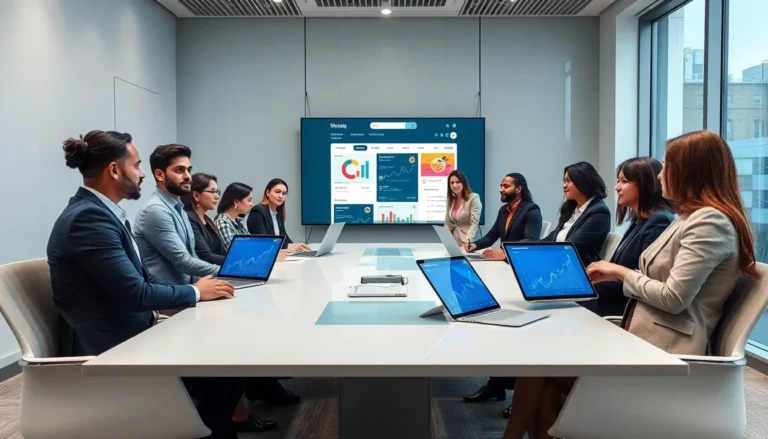Table of Contents
ToggleImagine trying to learn a new language while simultaneously navigating a bustling café, dodging spilled coffee, and deciphering a menu that looks like it was written by a mischievous raccoon. Welcome to the world of crosstalk language learning, where the chaos of real-life conversations meets the thrill of acquiring a new tongue. It’s not just about memorizing vocabulary; it’s about diving headfirst into the delightful messiness of communication.
Understanding Crosstalk Language Learning
Crosstalk language learning emphasizes the immersion experience in authentic situations, facilitating effective language acquisition through real-time interactions. This approach transforms learning into an engaging and practical venture.
Definition and Origins
Crosstalk language learning refers to a method that encourages bilingual conversations in natural environments. In the late 20th century, educators recognized its potential to enhance language skills beyond traditional classroom settings. The practice allows learners to experience spontaneous dialogue. This method stems from the understanding that language learning thrives in context rather than through rote memorization.
Key Principles
Active participation remains central to crosstalk language learning. Learners engage with native speakers, gaining immediate feedback on pronunciation and usage. Immersion in authentic environments accelerates understanding while exposing learners to diverse dialects and expressions. Real-life interactions promote adaptability and fluency. Collaborative learning plays a crucial role, allowing students to share knowledge and experiences, thus strengthening language retention and application.
Benefits of Crosstalk Language Learning

Crosstalk language learning offers numerous advantages that enhance the language acquisition process. Effective and practical, this method engages learners in real-life communication.
Enhanced Communication Skills
Active engagement with native speakers significantly improves language proficiency. Individuals develop quick thinking abilities as they navigate spontaneous conversations. Practicing in diverse environments, such as cafés or markets, reinforces vocabulary usage. Instant feedback from peers and mentors facilitates immediate correction of errors. Participants gain confidence while expressing thoughts, fostering meaningful dialogues. Over time, these interactions lead to fluent and natural communication, transcending traditional classroom constraints.
Cultural Exchange
Crosstalk learning encourages deep cultural insights that accompany language training. Engaging in bilingual conversations exposes learners to various cultural norms, expressions, and traditions. Authentic experiences allow individuals to appreciate nuanced meanings within different contexts. By interacting with diverse speakers, participants cultivate empathy and understanding across cultures. These exchanges promote connections that transcend language barriers. Ultimately, this approach fosters a global perspective, enriching the overall language-learning experience.
Techniques for Effective Crosstalk Language Learning
Crosstalk language learning involves engaging, interactive strategies that facilitate immersion and real-world use. Effective techniques enhance both comprehension and retention.
Interactive Activities
Interactive activities play a crucial role in crosstalk language learning. These activities include language games, role-playing scenarios, and storytelling sessions. Engaging with native speakers in these contexts allows learners to practice language skills dynamically. Using apps for language exchanges also promotes spontaneous conversations, encouraging learners to think on their feet. Involving song lyrics or movie dialogues increases enjoyment and context, making the learning experience enjoyable and relatable. By incorporating diverse activities, learners develop practical speaking skills that transfer seamlessly to real-life situations.
Collaborative Learning Environments
Collaborative learning environments significantly enhance language acquisition. Group discussions among learners create a sense of community, allowing for shared experiences and knowledge. Partnering with native speakers fosters authentic dialogue, building confidence and fluency. Utilizing platforms like language cafes invites diverse participants, exposing learners to varied dialects and cultural expressions. Frequent feedback from peers and instructors reinforces understanding, improving language retention. Collaboration nurtures empathy by emphasizing cultural nuances, enriching the overall language experience through shared learning pathways.
Challenges in Crosstalk Language Learning
Crosstalk language learning presents unique challenges that learners must navigate for effective communication.
Miscommunication Issues
Miscommunication often arises due to varying language proficiency levels among participants. Complex phrases can lead to misunderstandings, especially in fast-paced environments. Cultural nuances further complicate interactions, as learners might misinterpret idiomatic expressions. Learners frequently find themselves relying on context clues to comprehend conversations. Immediate feedback is essential for clarification; however, it might not always be available in real-time situations. Techniques such as repetition and paraphrasing can aid in reducing confusion. Establishing a supportive atmosphere where learners feel comfortable asking questions promotes better understanding.
Balancing Between Languages
Balancing between languages poses a significant challenge in crosstalk language learning. Learners may struggle to switch between their native language and the target language seamlessly. Code-switching, while a natural tendency, can hinder fluency. Managing vocabulary retention becomes crucial in mixed-language conversations. Learners might also feel pressure to speak perfect sentences, which can stifle spontaneity. Embracing mistakes is vital, as it fosters a learning mindset. Strategies such as setting language goals and dedicating specific times for each language can help in maintaining equitable usage. Prioritizing balance leads to improved confidence and practical application in diverse linguistic settings.
Crosstalk language learning stands as a transformative approach that reshapes how individuals acquire new languages. By immersing learners in real-life interactions they gain invaluable skills that extend beyond traditional methods. This dynamic technique not only fosters fluency but also cultivates cultural understanding and empathy.
Through engaging with native speakers and participating in collaborative environments learners can navigate the complexities of language with confidence. While challenges exist the rewards of crosstalk learning far outweigh the obstacles. Ultimately it empowers learners to communicate effectively and connect meaningfully across diverse cultures.








